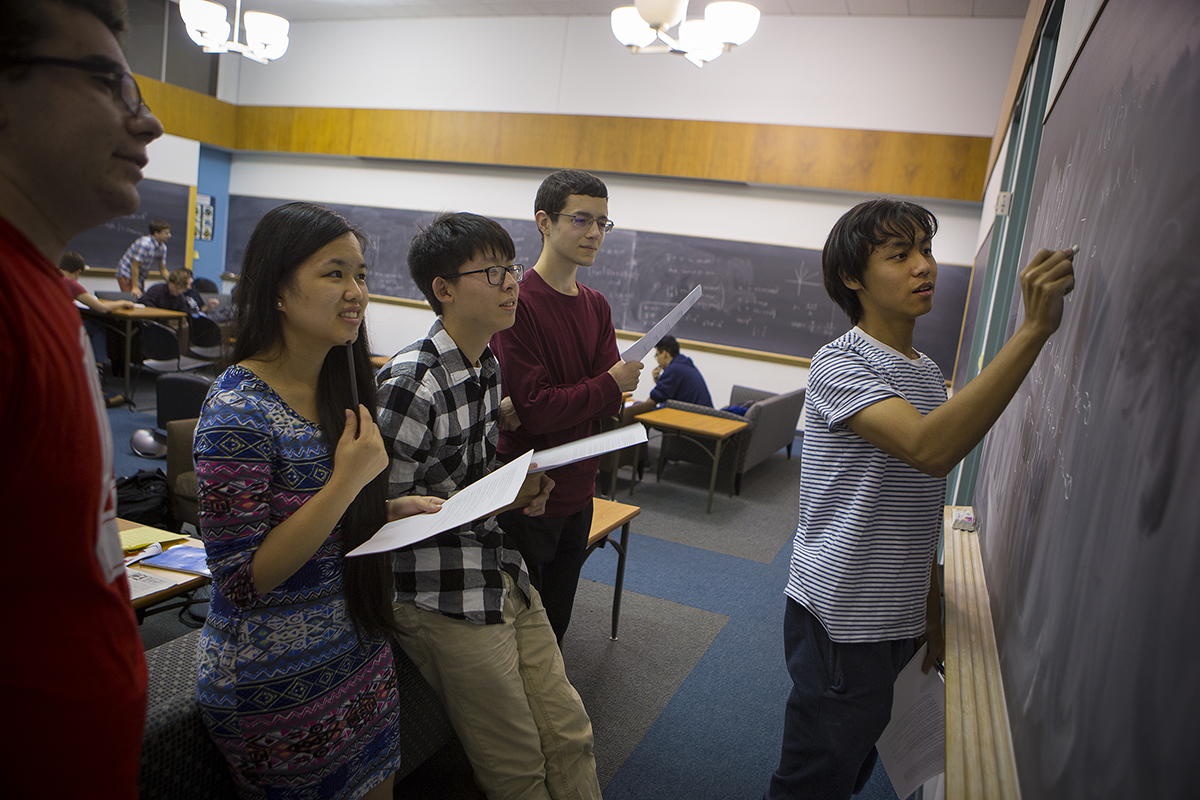Freshmen tackle upper-level math in special course
By Kathy Hovis

Every Wednesday night, students gather in the math lounge of Malott Hall and spend 2.5 hours huddled around chalkboards and poring over textbooks as they seek solutions to some of the most vexing math problem sets a first-year student might encounter in Theoretical Linear Algebra and Calculus.
These are problem sets that could stump even a graduate student, but with this group of young mathematicians, the challenges are welcome.
“It’s easy to get obsessed with a problem and work on it for hours,” said Katie Borg ’20, one of the students in the class. “Once you start working on it, you can’t stop until you solve it.”
Words like that are music to the ears of John Hubbard, professor of mathmatics, who created this course 20 years ago for students who were fascinated by math and weren’t challenged enough by traditional classes. Hubbard and his wife, Barbara Burke Hubbard, wrote the class’s textbook: Vector Calculus, Linear Algebra and Differential Forms: A Unified Approach, now in its fifth edition.
“Part of my motivation was to change the collegiate curriculum, to create a substantial population of people who think about questions like, ‘How did Facebook tag my friend in that photo?’ ‘What can we do about global warming,’” Hubbard said. “These are all mathematical questions to a certain extent.”
Hubbard said he was always disappointed with the second-year math curriculum (his first-year class is patterned on this second-year curriculum), which traditionally split linear algebra and multivariate calculus into two semesters, so his textbook combines them.
“Linear algebra is better used as a language to do calculus rather than a class on its own,” Hubbard said. “Each chapter in the book has two sections – one on linear algebra and another using what you just learned to do in calculus.”
Each fall, about 50 students enroll in the class, said Ravi Ramakrishna, math professor and department chair, who is teaching the class this semester. After a few weeks, enrollment usually drops to about 25 students, but this year 30 students still remain.
Topics covered include everything from matrices and transformations to the geometry of curves and surfaces. The class includes two weekly lectures with Ramakrishna and the Wednesday night session with doctoral student Daoji Huang.
“This class is great because the students are automatically engaged,” Huang said. “But sometimes I have to work really hard to come up with problems for them. You have to be on top of things because they are really on top of things.”
“In this class, you’re introduced to the paradigm of pure mathematics,” said Caleb Koch ’20, another student in the class. “It’s challenging because you’re trying to work on something that’s highly abstract.”
Koch said the challenging problem sets have helped him to develop his “intuition” about the best way to start a problem. Another benefit of the class is the requirement that students write up their solutions using prose, sometimes along with equations, sometimes without.
“One defining aspect of math is the freedom to choose how you want to give your solution,” Koch said. “Sometimes you’ll find a mistake as you’re writing it out or you’ll discover a better way to get to the same solution.”
Ramakrishna said the writing process is time-consuming but important. Students use LaTeX, software that allows them to easily include equations in their documents.
“These are basically like the top runners who have natural ability but haven’t been pushed by the competition to their full abilities yet,” Ramakrishna said. “There’s only one way to get to be a faster runner, and that involves a lot of hard work.”
The class syllabus indicates that students will spend at least 15 hours a week on homework. “Mathematics is challenging, but mostly it’s beautiful ... and fun!” the syllabus reads. A take-home prelim, due Nov. 22, will take them between 30-50 hours, Ramakrishna said.
“This is one of the most demanding classes at a world-class university,” Ramakrishna said. “That’s what you should expect.”
None of these challenges seem too daunting to the students still in the class. Nor are they studying math and hoping to use it to solve an imminent real-world problem.
Koch is studying theoretical computer science not to become a programmer, but to explore the limits of what computers can do. For that, he’s taking a rigorous load of math classes, as well as courses in philosophy and computer science. Borg is also interested in computer science, as well as in linguistics and medicine.
“Pure mathematics does not necessarily relate to the real world, but it’s in some sense like literature. Reading great prose is really a joy,” Ramakrishna said. “With math, 50-100 years down the road, it may turn out that what we’re doing is applicational, but the time frame is so long that you may never know.”
Alumni from the class are a distinguished bunch, Ramakrishna said.
“This class has produced a good number of mathematicians,” Ramakrishna said, including students who went on to graduate degrees in computer and information systems at Berkeley, physics at Columbia, economics at Harvard and math at Princeton, Harvard and Caltech, among other notable institutions.
Kathy Hovis is a writer for the College of Arts and Sciences.
Media Contact
Get Cornell news delivered right to your inbox.
Subscribe